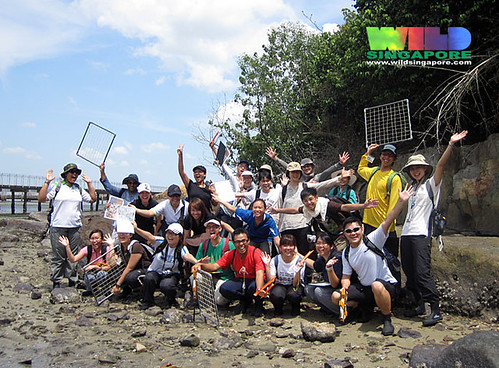
(Photo by Ria)
Today is Blog Action Day, and this year's theme is The Power of We.
The Power of We is a celebration of people working together to make a positive difference in the world, either for their own communities or for people they will never meet half way around the world.Today also marks the start of the Northern Expedition of the Comprehensive Marine Biodiversity Survey (also affectionately known as the Mega Marine Survey). Although this effort has been spearheaded by local scientific bodies, and the visiting specialists form an invaluable element of the team, much would not be possible without the contributions of volunteers as well, who will be participating in various roles, from collecting specimens during field surveys, to sorting and preservation, to photography. In a sense, this is the culmination of close to 2 years of leading volunteers in carrying out smaller surveys. And this is just the first of several major expeditions planned for the next few years.

Volunteers hard at work on the mudflats of Kranji;
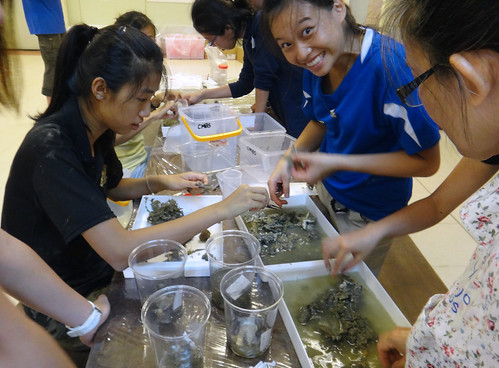
Sorting specimens collected during surveys at Pulau Ubin;
(Photos by Ria)
Similarly, volunteers form the backbone of many other groups and organisations, and anyone who's interested in making a difference can contribute, whether it's in terms of communicating the importance of our green spaces to the general public, or offering an additional pair of hands to haul rubbish out of a mangrove.
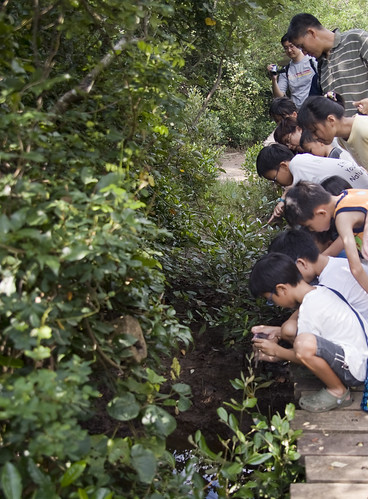
Children fascinated by the sights on the Chek Jawa Boardwalk;
(Photo by Ria)
For instance, people with a desire to share the beauty of our natural heritage can sign up to become guides with groups like the Naked Hermit Crabs and the Raffles Museum Toddycats!.
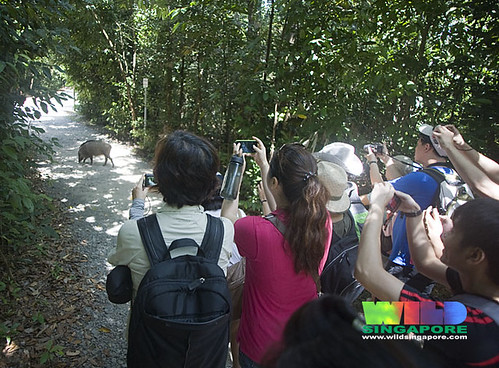
Naked Hermit Crab guide Ley Kun leading a group of visitors at Chek Jawa, showing them how to behave appropriately when crossing paths with a wild boar;
(Photo by Ria)
![51festival-of-biodiversity_singapore_botanic_gardens_26may2012[bz]](http://farm9.staticflickr.com/8167/7293567168_c610c6fa09.jpg)
Toddycat Tze Kwan talks to a certain VIP about our wildlife at the Festival of Biodiversity;
(Photo by Zuze, on Habitatnews)
Those who are keen in contributing to field research can join the Mega Marine Survey, TeamSeagrass, or the Mangrove Action Squad.
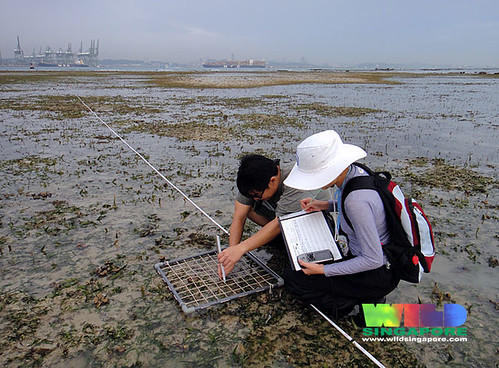
Monitoring seagrasses at Cyrene Reef;
(Photo by Ria)

Mapping trees and surface elevation in Mandai mangroves;
(Photo by Rick)
Maybe you are concerned about the impacts of trash on marine life; you can be involved in the International Coastal Cleanup Singapore or Project Driftnet.
![09earth-day-cleanup-tanah-merah-28apr2012[xu-weiting]](http://farm9.staticflickr.com/8145/6981033486_3d27072383.jpg)
Removing trash from a shore at Tanah Merah;
(Photo by Weiting, on Habitatnews)
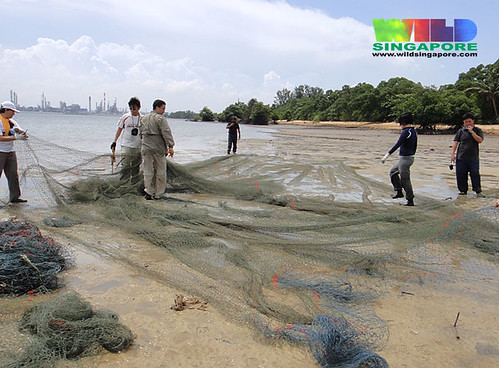
Disposing of a large net deposited on the shore at Pulau Semakau;
(Photo by Ria)
There are so many other groups and organisations out there which rely on ordinary citizens who are committed towards spending their time and energy to raise awareness of our natural heritage, or who are actively involved in research and conservation efforts.
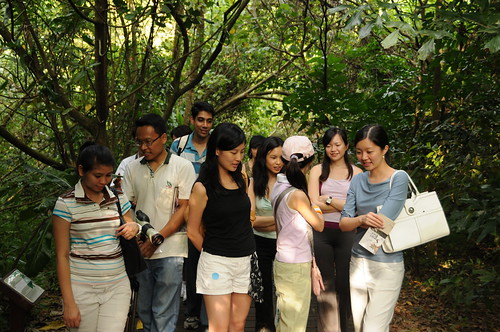
A guided walk at Sungei Buloh;
(Photo by terrapungent)
You can rescue wildlife in distress with the Animal Concerns Research & Education Society (ACRES), run educational programmes for children as part of Cicada Tree Eco-Place, or help to enhance urban biodiversity with Butterfly Circle. You can guide visitors around Sungei Buloh or carry out reforestation projects in the Central Catchment Area as a volunteer with the National Parks Board (NParks), or simply join the many activities offered by the Nature Society (Singapore). Whether you decide to do something in your own personal capacity, or manage to convince your colleagues to commit as part of corporate social responsibility (CSR) obligations, you are helping to show others that Singapore's biodiversity is worth protecting.

Andrew helps children learn about reptiles during a workshop held by Cicada Tree Eco-Place;
(Photo by *Damselfly*)
Even if you don't have the time to take part in volunteer-based activities on a regular basis, you can still join guided walks as a visitor, or head out on your own to explore. There are plenty of activities organised by various groups, and many of them are catered towards families with young children: Wild Happenings in Singapore has a list of upcoming events. By sharing and publicising your own encounters and experiences while visiting parks and other nature areas, you too can help increase public awareness of these places, and the often remarkable wonders that they contain; a lot of people are still woefully unaware of the beauty that is to be found in our green spaces, and besides, there are still plenty of gaps in our understanding. Much of what we know about our wildlife is based on sightings and observations shared by people who visit our nature areas as part of a hobby, whether it's birdwatchers, macro photographers, or ordinary parkgoers on a family outing. Just the simple act of posting photographs up on Facebook, writing about your experiences on your personal blog, or submitting a record to the Bird Ecology Study Group or Mammal sightings in Singapore, for example, can help increase awareness of the treasures that still survive here in Singapore, and even lead to further research.
What if you're someone with no background knowledge about biodiversity, or no experience in identifying plants and animals? Everybody starts off with a blank slate, and you really don't need to be a scientist or have a degree in Biology in order to contribute; all you need is the passion to be involved, and the willingness to learn, often on the job. Many research projects don't require people with in-depth technical knowledge; sometimes, the basic need is an extra pair of hands, whether it's to move equipment or record data. This is especially the case with small individual projects, which often lack the budget to hire research assistants, instead relying on the goodwill and free time of others to help out.

Assisting Amanda's small mammal study for her Honours project;
(Photo by Gladys)
Much of the knowledge that we gain comes from reading up on our own, attending training sessions, and simply being out there in the company of others who are more experienced. Even the most seasoned guides are always referring to available resources, and most importantly, they teach one another, exchanging facts, imparting tips. The best way to learn how to become a guide is to follow someone more experienced, subsequently gaining the confidence and knowledge to lead a group on your own. And it doesn't matter if you're a student in secondary school, or a retiree; you're never too young or too old to learn new things. Many visitors simply don't notice something until a guide points it out to them. But once they get the hang of things, and realise just how much there is to see, often in plain sight, they themselves can become inspired to take a more active interest in nature, and may even end up becoming guides themselves.
![28toddycats-training-festival-of-biodiversity-23may2012[ss]](http://farm8.staticflickr.com/7104/7260325940_c31fb7ef0b.jpg)
A training session for Raffles Museum Toddycats!, in preparation for the Festival of Biodiversity;
(Photo by Sarah, on Habitatnews)
Through the combined efforts of many people, whether it's in research, documentation through photography, habitat protection and restoration, outreach through guided walks and educational activities, advocacy by speaking up via public platforms about issues, or simply visiting and appreciating our wild places, we can each play a part in showing that there is another side to Singapore, one that deserves a lot more attention from the general populace.
It's easy to feel despair and hopelessness when grappling with many of the pressing issues and challenges regarding conservation in Singapore. But it gives me a great sense of motivation when I see other like-minded people with the passion and drive to do something, people who bring to the table their own set of skills and capabilities, with each individual doing his or her part to help foster and nurture a greater appreciation for an often overlooked aspect of living in a small island nation at the heart of a hotspot for biodiversity.
To be champions for our natural heritage, with everyone's efforts ultimately contributing towards a heightened awareness about our place in this world, as one link in an interconnected web of relationships, much of which we are still only just beginning to comprehend: that is The Power of We.
TL;DR: You can make a difference for nature in Singapore, even if you're not a scientist or self-styled environmental activist. Explore, Express, and Act!